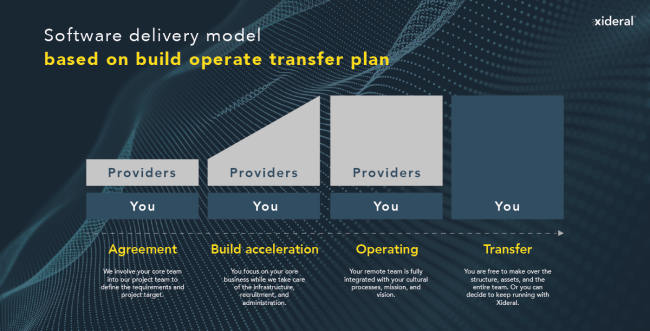In these crazy times, the need for digital transformation has become more evident than ever in all sectors. The BOT model has proven to be an excellent way to handle these changes and add value.
What is the BOT Model?
It stands for Build-Operate-Transfer, and it’s a business approach that involves building an operation or project, operating it for a specified period, and then transferring it to another entity, typically the original client or owner. This model is commonly used in outsourcing projects or technology development, where an external company builds and operates part or all of the project before gradually transferring responsibility and control to the client or owner once certain predefined objectives or conditions are met. The BOT model provides flexibility and allows organizations to benefit from third-party expertise before taking full project management.
Due to digital adjustments, companies need to evolve rapidly and acquire new skills. These tasks must be done correctly but also quickly. As new technologies emerge, it’s necessary to change how we manage our businesses.
Let's focus on how this strategy accelerates digital transformation.
In the past few years, business leaders have made faster decisions regarding digital conversion. Despite investing in experts, many have not reached their goals.
Changing how you operate and continue delivering value is not easy.
Many companies have been pushed toward business transformation. And while improving training and people’s skills has been helpful, it’s necessary to accelerate learning at all levels.
At Xideral, we’ve worked with the BOT model in Latin America and Canada, and we understand the need to stay up-to-date in the digital world. We’ve also seen the challenges that hinder successful digital transformation. Often, companies want to redesign their operations, but they do it at an insufficient pace.
A common mistake is thinking that digital transformation depends solely on technology.
In reality, it should be a joint effort between technology and the business. Finding and retaining the right people, especially in areas with a shortage of digital talent, is also a challenge. Lack of leadership and slow decision-making hinder a quick response to competition. The fear of change also plays a significant role in impeding progress. Many leaders don’t take this issue seriously and leave cultural changes to the end.
In summary, the lack of experience in managing business transformation makes the transition to digital more challenging. That’s why the BOT model has proven to be useful, providing the flexibility and scalability needed to succeed in the digital world.
Why choose the BOT model?
By implementing it, companies learn to manage their own digital and business transformation. Instead of relying on external providers, this model allows them to control their priorities and become operational immediately.
A significant benefit is risk reduction:
Clients acquire the project at the end of the process only if it meets quality and efficiency standards. The BOT model also addresses IT operations team challenges, facilitating the transition of technology with an exit strategy in mind. This means clients aren’t just consuming a product but building a long-term operational platform. Developing digital skills by hiring, nurturing, and retaining experts is crucial and should not be outsourced. With the right structure and processes, this model works closely with clients, providing continuous and innovative guidance.
Staying competitive in the digital world is a major concern for business leaders.
Considering that by 2025, 75% of the workforce will be millennials, adaptation is essential. This is where the BOT model plays a prominent role, as it not only offers specific benefits but also extraordinary value.
A significant benefit is risk reduction:
Clients acquire the project at the end of the process only if it meets quality and efficiency standards. The BOT model also addresses IT operations team challenges, facilitating the transition of technology with an exit strategy in mind. This means clients aren’t just consuming a product but building a long-term operational platform. Developing digital skills by hiring, nurturing, and retaining experts is crucial and should not be outsourced. With the right structure and processes, this model works closely with clients, providing continuous and innovative guidance.
By taking steps to quickly build a dedicated team with the necessary skills, other areas can also be improved:
- Human resources: The outsourcing partner handles the recruitment, hiring, and training of your team of experts, relieving a significant burden and ensuring optimal performance.
- Business management: An experienced team can help manage daily operations, communications, and reporting, benefiting overall business management.
- Sales and acquisitions: The BOT model helps organizations advance by enhancing their capabilities and reducing initial investment and risk, allowing clients to focus on sales and achieve results faster.
